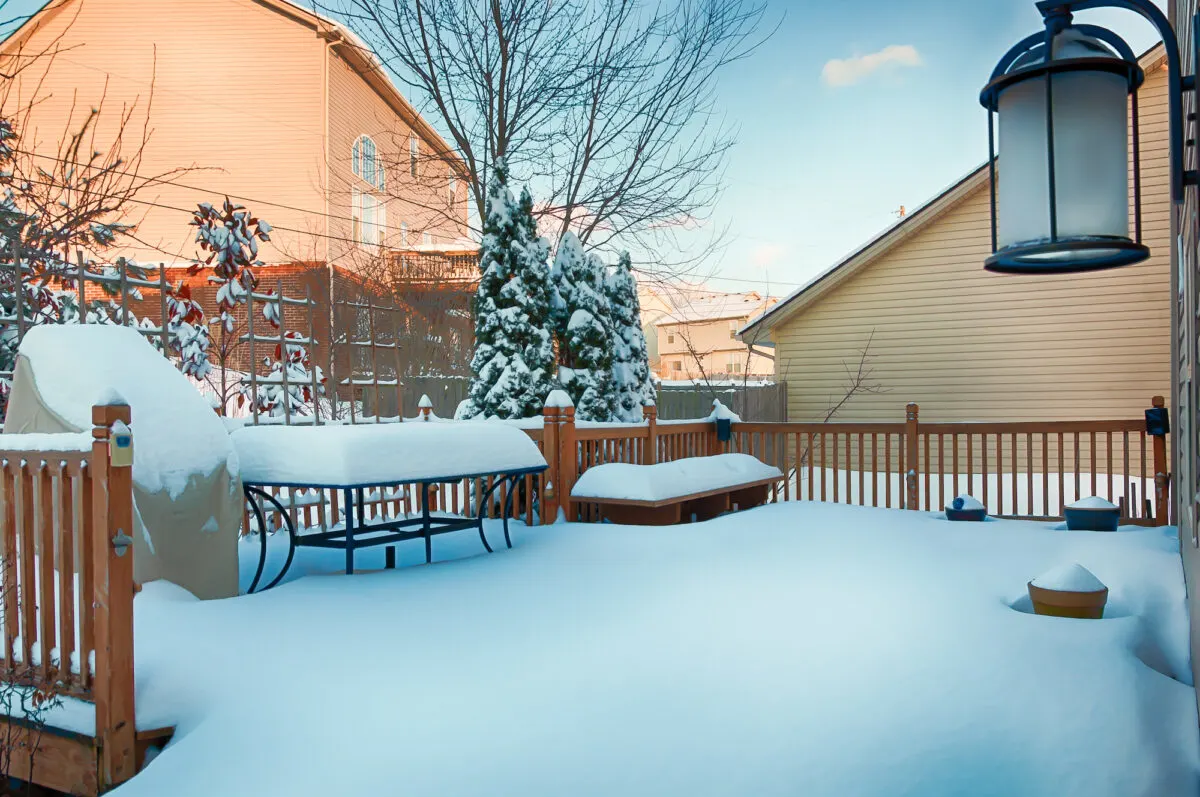During a winter of heavy snow, you might be wondering how all of the moisture is going to affect your composite decking? If you have a deck made from Trex or other composite materials, you could be concerned whether ice melt can be used, or if a shovel will damage the deck.
Removing snow is hard, physical work, too. You could be concerned about your physical ability to lift or push that much weight. Or perhaps you are a new homeowner and you haven’t had time or money to buy the winter weather supplies that you need.
The good news is that you can remove snow and ice safely from composite decking or your balcony without damaging the material. Plus, you can easily do it with common household tools or inexpensive gadgets to stock up on right now.

Be sure to see my other snow and ice removal tips, too:
- How to Remove Snow Without a Shovel
- Ways to Remove Snow from your Roof
- How to Remove Snow from a Satellite Dish
- Rock Salt for Snow Removal
Ways to Remove Snow from Composite Decking
There are several different methods you can use to safely remove snow from your composite decking. Which method is right for you will depend on the equipment you already own and the amount of snowfall that you have.
Be careful when walking on your decking as you are removing snow or ice. You don’t want to slip and fall. These Kahtoola NANOspikes can be slipped on over your normal shoes to provide traction. However, they don’t have sharp metal points which would damage your decking. They are smart to have on hand for winter weather and they fold ups easily for storage.
Leaf Blower
A leaf blower is a common household tool and a handy way to remove light, fluffy snow from your deck. Using a leaf blower is ideal, as you won’t risk damaging your decking with scratches from a shovel or exposure to chemicals. It’s also easier to handle and operate compared to shovels or rakes.
A leaf blower is definitely a better choice than a snowblower! A snowblower’s sharp blades could easily scratch up your decking.
However, a leaf blower won’t work on dense layers of snow. If you’ve got a lot of snow build up, or if it’s starting to freeze with ice, you are better off using a different method.
Plastic Shovel
A plastic shovel is an excellent way to get rid of dense layers of snow, without worrying about scratching the decking with a metal blade.
Obviously, a plastic shovel is weaker than a metal one, so try to shovel smaller amounts. Otherwise, the plastic shovel may break from the weight of the snow.
You shouldn’t use a metal shovel on your composite decking as you risk scratching, denting or chipping your composite decking.
Related Post: How to Remove Snow from a Truck Bed
Snow Broom
A snow broom is another great method of removing snow. But it’s not one that most people are familiar with.
Snow brooms don’t even look like a traditional broom. Instead, they look like a very large squeegee. There are telescoping poles which allow you to adjust the height of the handle. They can be used on decks, as well as vehicles.
These inexpensive gadgets (approximately $20-$30) will sweep away light coverings of snow, without the risk of scratching up the deck. These aren’t great for heavy snowfall, but they are ideal for removing snow as it begins to fall during a snowstorm.
If you don’t already have a snow broom, they are a great investment to have on hand. A bonus is that they can be folded down and stored out of the way in your garage.
These unique tools can be one of the best ways to remove snow from solar panels, too.
Rake
A rake can come in quite useful if you’re short on tools and are looking for a way to break up large, dense clumps of snow and ice.
Similar to a shovel, you will want to avoid using this close to the deck, as it will damage your decking if you accidentally strike it.
However, a rake is not ideal for sweeping away snow. It is best used along with another tool.
A bow rake is more sturdy and will work better at breaking up thick chunks of snow and ice. However, if you have a leaf rake, that could work, too.
Snow rakes are made specifically for removing snow and are very similar to snow brooms.
Heat Mats
If you want to avoid snow build up from the moment that the flakes start falling, then you will want to use a heat mat.
Heat mats are laid down on your deck or walkways before snow starts to fall. They are electric warming mats that will melt any snow and ice.
These are perfect to keep walkways clear without needing to shovel. If you have a dog that needs to be walked, it’s smart to keep a clear path from your door without any ice or snow.
Most heat mats melt snow at a rate of two inches per hour, meaning they can deal with most snowstorms with little effort.
Heated snow melting mats are the most expensive ways to prevent snow build up on your deck. However, they do prevent needing a lot of manual labor to remove snow or ice during or after a snowstorm.
Calcium Chloride Solution
If you have some time to wait for the snow to melt, then Calcium chloride snow and ice melt is a great method of removing it.
Calcium chloride solutions are much safer than using sand and traditional rock salt, which will leave marks across your deck and possibly damage the finish.
Even though calcium chloride is safer, it is still recommended to rinse away all of the residue after using, just to be on the safe side.
Again, this is a more expensive method of snow removal. But it doesn’t require as much work on your part.
Be sure to check out all of our helpful Emergency Preparedness articles for dealing with snow and ice.
The Best Time to Remove Snow from Composite Decking
Removing snow from your deck is essential to make sure it stays in good condition. Everybody’s deck is different, so it can be tricky to know when the best time is to sweep away any snowfall.
The good news is that composite decking doesn’t become as damaged from moisture as wood decks do.
Assuming that your composite decking is structurally sound and relatively new, the chances are it can withstand up to three feet worth of snow.
While your composite decking can hold up against quite a lot of snow, it’s important that you remove any snow well before it gets nearly three-feet deep, though.
The weight of snow and ice can test the structural integrity of your deck. And then if you are standing on your deck when cleaning it, you will add a significant amount of weight to the boards, which could cause your deck to cave in or collapse.
Depending on whether you have a waterproof deck or not, snow could also cause some unseen damage. Any decking which sits under snow for an extended period could soak up a lot of moisture, which might cause mildew, rotting and other damage.
These same problems can affect other small structures in your yard, too, so be sure to see our tips for how to remove snow from a gazebo.
Considering these factors, you will want to clear snow off your deck, if possible, when the snow is 6 inches deep or less. This way, you can avoid damage caused by leaving the snow to accumulate for long periods and make sure your deck doesn’t collapse under the weight of heavy snowfall.

